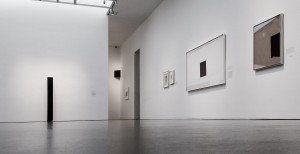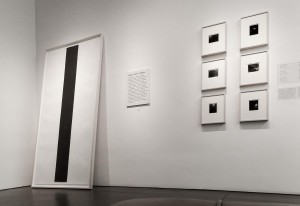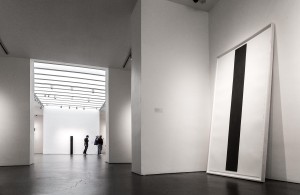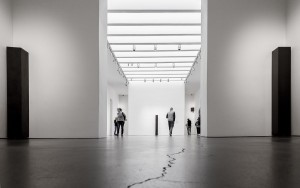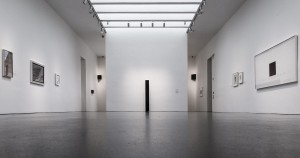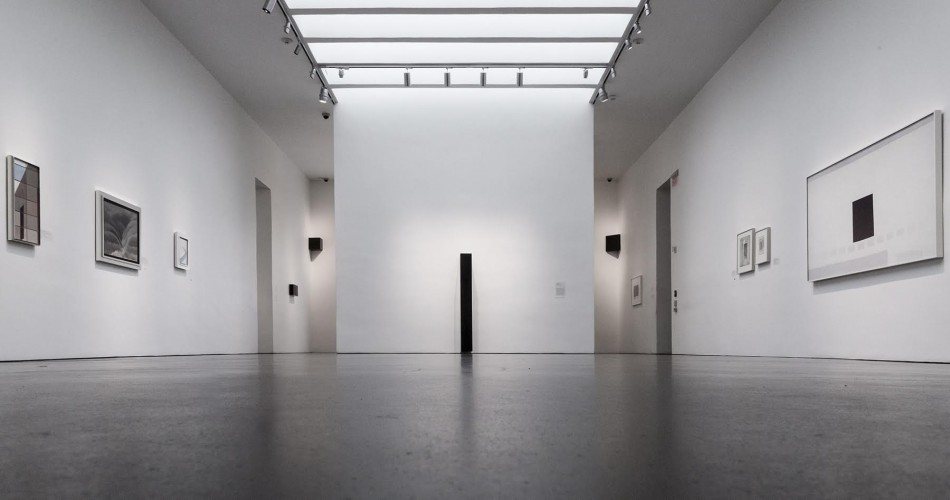
Susan York at the O’Keeffe Museum
Most of the time one doesn’t think of painting as volume, because a volume implies a third dimension. But on touring the Georgia O’Keeffe Museum’s winter show, Susan York: Carbon (January 21-April 17. 2016), it was easy to submit to a sense of pleasurable dislocation imparted when works of two dimension meet works of three, as in the meeting of O’Keeffe paintings and Susan York’s graphite sculptures. (Images are courtesy of the artist. Photographs: Larry Fodor.)
While being three-dimensional, York’s sculptures nevertheless make use of the wall — of the bearing walls of architecture — to juxtapose weight and impenetrability with conditions of lightness, even translucency, that the mind improbably reads into their black surface.
Art’s manifold geometries both on flat planes and tilting ones helped make the 20th-century a time of restless innovation and experiment. In this exhibit, one could review O’Keeffe’s determinism with the color black from as early as the watercolors she made of Palo Duro Canyon in West Texas (1916-1918), to Black Place paintings named for one of her favorite spots in the Abiquiu hills. It was also interesting to see O’Keeffe revisiting subjects later in life that she had first taken up five decades earlier: A black barn door at Lake George with a flagpole outside and a weathervane overhead. Black Manhattan skyscrapers leaning into a night sky pocked by stars. The door of the Abiquiu house as a black-on-beige study but for one green leaf stilled in its descent toward ground.
I was relieved in a way by this show. It revealed something about art’s nature as poetics, as representing formal — maybe the utmost of formal — negotiation with a measurement that in language might be called an iamb, a form-delimiting metric. Poets have always sung to readers in written text, hoping for the page to stir the blood. Artists contend with imposed conditions of flatness and dimensionality to stir our sentience — our sense of walking vertically upright and peering at the world shaping itself in front of us.
I have known Susan York for long enough to remember that she used to make porcelain shards that she then cautiously propped, lined up inside of metal brackets setting an endnote on a line that could at least conceptually prefigure infinity. The tension between that shard so thin, by definition brittle yet occupying a repose of object-hood, made the work interesting. It questioned ceramic as pottery fragment’s relation to urn. The root word might connote a container yet not prescribe one.
By 2007, York was experimenting with graphite— yes, the stuff of No. 2 pencils — in solo gallery shows.
Exhibitions 2D in Marfa, Texas made a gallery venue for York where the corner of the room functioned for her as it had for Kasimir Malevich, father of Suprematism, in his “desperate (1913) attempt” to free art from “the ballast of objectivity.” Hence these non-objective paintings secularized actually the spot that a Russian icon might have held — in a high corner where adjoining walls meet ceiling.
Malevich’s painted volumes on white ground — circles, cruciforms, squares — ticked along and still do, setting off those tremendously interesting conversations among artists and art historians who stood and stand agog at the implications of his mute, ineffably powerful action of visual declamation.
Malevich called Black Square the zero of painting, and Suprematism was correspondingly the “zero” of form.
Lannan Foundation in its mud-floored Santa Fe gallery in 2008 invited the artist to do a graphite sculpture install in the space. The most Space Odyssey piece hung from the ceiling (talk about a load-bearing bond beam). Visitors made their way around it a little bit like you see in pictures of people touching the Maya Lin Vietnam War memorial in Washington, DC.
York’s rubbing of graphite extended to her treatment of an Alcove show at the New Mexico Museum of Art. She rubbed and rubbed graphite on a wall surface until it shone lustrous.
Yet while for York, materials have taken her along a path leading to purer and purer abstraction, O’Keeffe of course did not herself continue to preference abstraction over representation in her burgeoning career. She turned to representational forms en route to becoming the godmother of desert aesthetics. In part that owed to the fact that from the 1920s and her arrival in New York, the merest curl of gesture evoked in critics’ analyses the curve of a breast, or another anatomical fold. (See this link about the impact of criticism on her work.).
York, who as a high-school student wrote a letter to O’Keeffe, has traced an arc of sorts between herself and minimalist sensei Agnes Martin. Getting to exhibit at the O’Keeffe Museum as a woman artist has been limited to a very select few who first fit into a Living Artists of Distinction category. Before that series was discontinued in 2012, the museum showed Anne Truitt, Sherrie Levine, Susan Rothenberg and Jaune Quick-to-See Smith under the LAoD moniker. Since 2013, solo shows for Annie Leibovitz, and now York, have conjugated O’Keeffe’s history with contemporary currency. Curator Cody Hartley observed that integrating Susan York’s installation into the O’Keeffe galleries marked a first for the museum in handling a show intended to spotlight “creative practice.”
Perhaps all that is to be said is that it is art’s promise to let you see things you feel you have mastered — in the sense of understanding — in a new way that is sometimes engendered by the relationship between “creative practices” adjoined.

